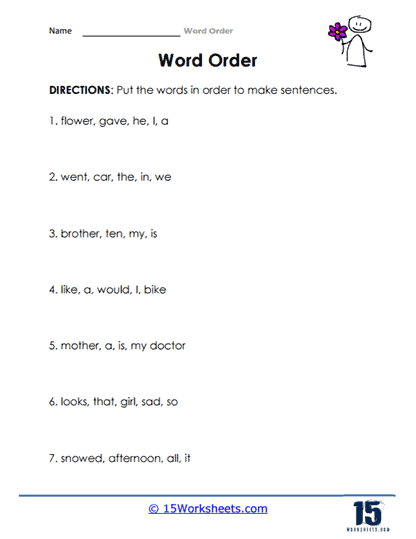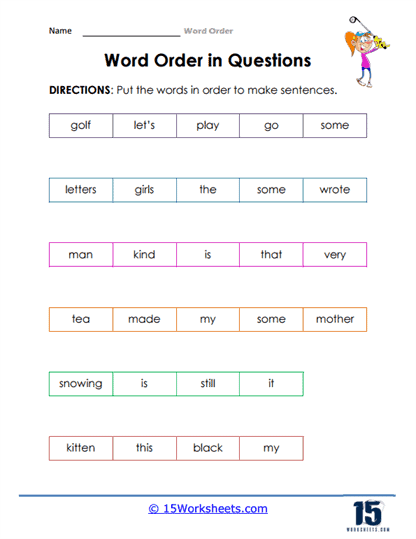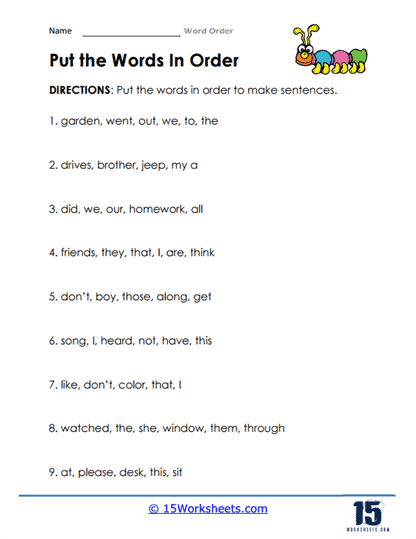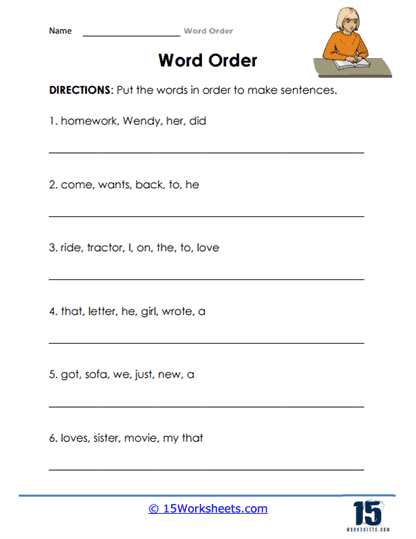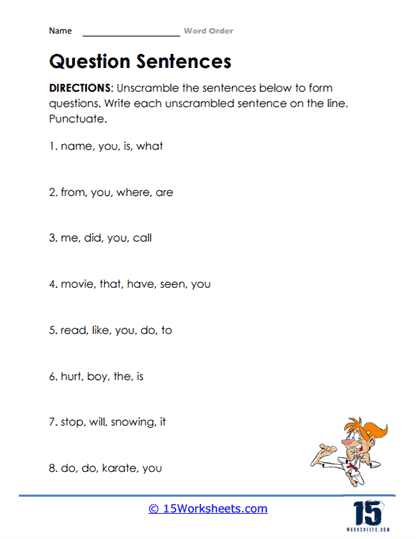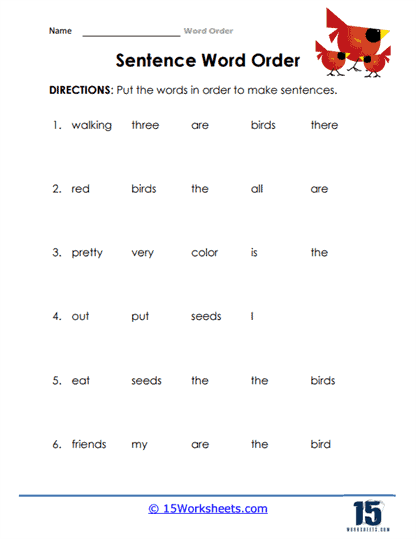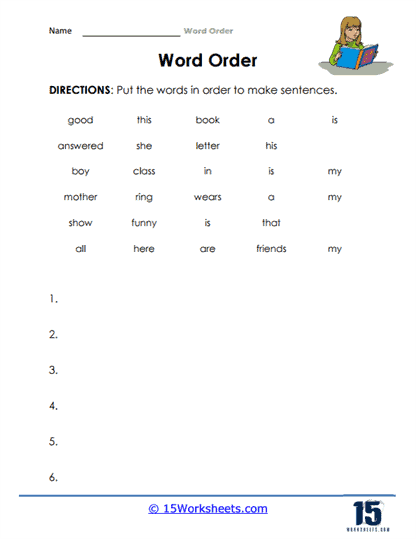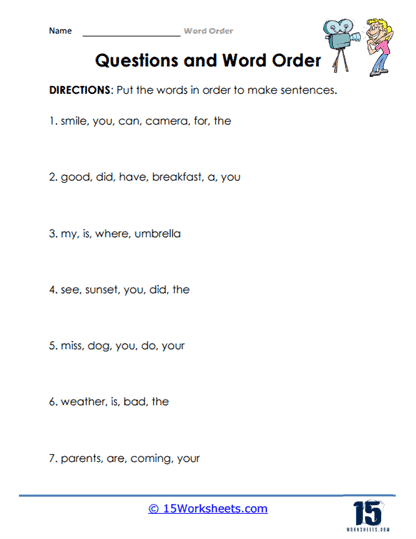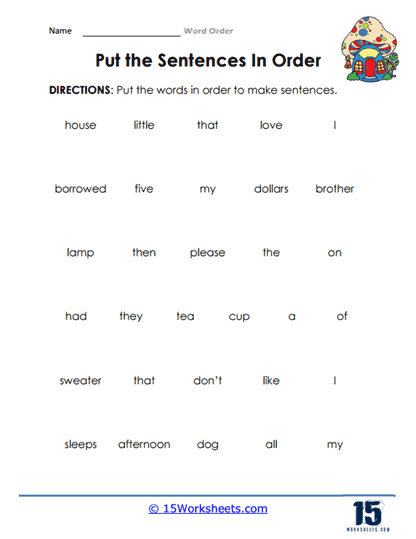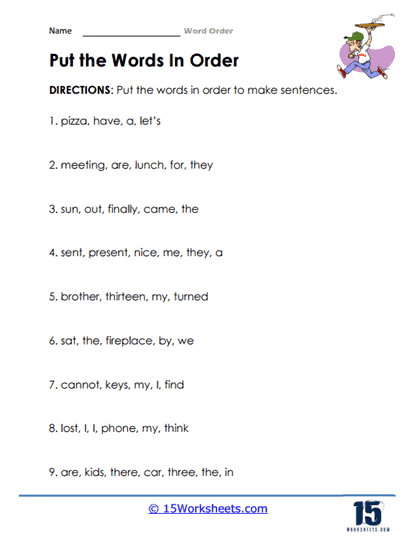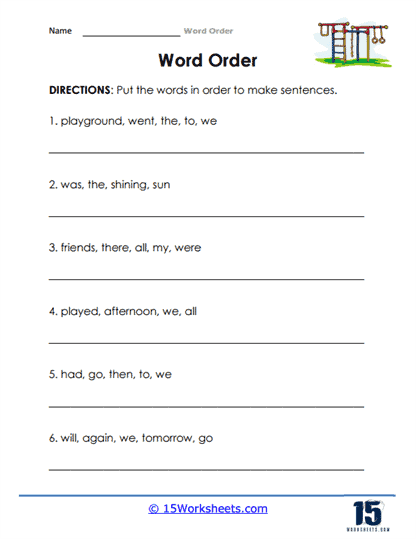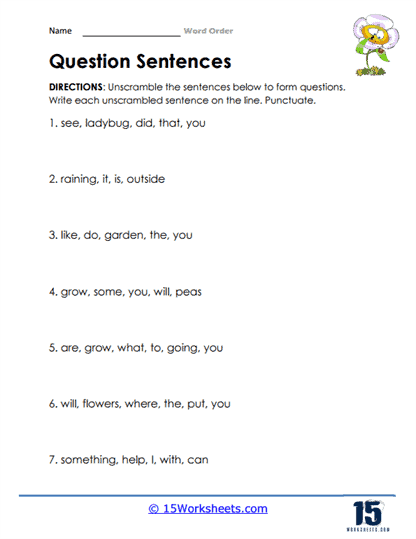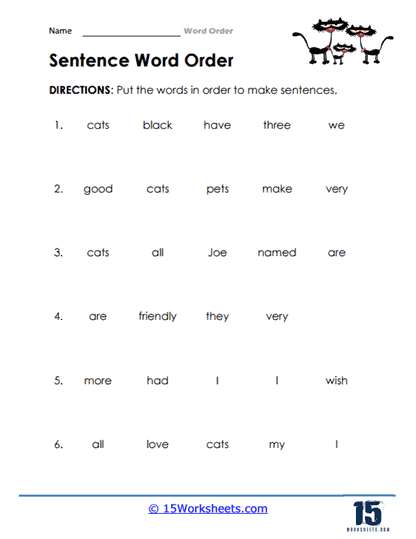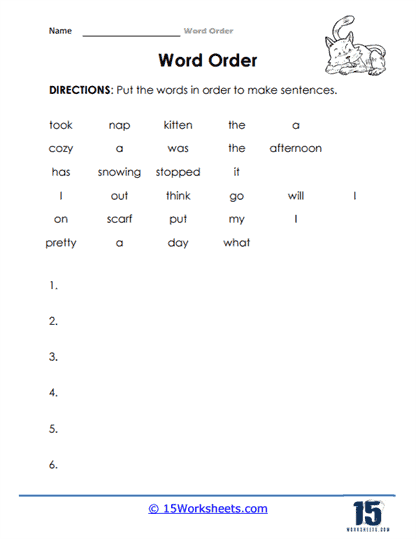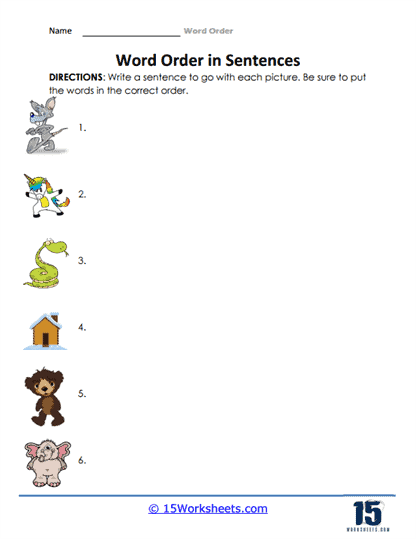Word Order Worksheets
All About These 15 Worksheets
This series of 15 worksheets is designed to help students develop a strong command of word order in their written compositions. They specifically focus on understanding the importance of word order and its impact on sentence structure, clarity, and meaning. With engaging exercises and practical examples, students will enhance their writing skills and create sentences that flow smoothly and effectively. Through these worksheets, students will:
- Understand how the arrangement of words within a sentence affects its meaning and how improper word order can lead to confusion or ambiguity;
- Grasp the basic rules and conventions of word order;
- Practice constructing grammatically correct sentences with proper subject-verb agreement;
- Position adjectives, adverbs, and other modifiers correctly to provide precise descriptions and enhance the overall impact of their writing;
- Create their own sentences while observing proper grammar rules and word order;
- And develop skills in identifying and rectifying word order errors, ensuring that their sentences are coherent, logical, and effectively convey their intended meaning.
In summary, these Word Order worksheets provide students with the tools and knowledge necessary to develop proficiency in word order. By completing these worksheets, students will enhance their understanding of sentence structure, clarity, and meaning. Whether constructing simple sentences or crafting more complex compositions, students will develop the skills to create writing that flows smoothly and effectively communicates their ideas.
What is Word Order in Grammar?
If you jot down random words to form a sentence, it will never make sense. Every language requires an order or arrangement to appear comprehendible. This arrangement is called syntax. The rules of syntax suggest that a basic sentence must contain subject, object and verb. A grammatically correct sentence should follow the rule of Subject-Verb-Object. This blog will discuss this form of sentence order along with other examples of word orders are also included in.
What is the Subject-Verb-Object rule?
The one performing an action is a subject; the action is called a verb or a doing word; and on which the action is performed is an object.
- For example: Allie kicked the ball.
Here, Allie is a subject, kicked is a conjugated form of verb, and ball is an object. Observe that subject and verb are always together. This is an example of basic word order.
What is the correct placement of adjectives?
Adjectives act as modifiers for nouns, which can be either subject or object. It is important to know where to place an adjective, so the meaning of the sentence is not changed. Adjectives can be placed at the end of a sentence after a verb. For example:
- Nora’s house is decorated beautifully.
- The weather became extremely cold.
However, adjectives are more commonly placed before nouns and can be in multiple quantities in a sentence.
- The red car was driving at a high speed.
Word Order for Adverbs
Adverbs describe a verb in a sentence. There are three ways to place an adverb in a sentence.
– You can place it before the subject, i.e., at the beginning of the sentence.
For example: Yesterday, I took the wrong turn for school.
Here, yesterday is an adverb placed before the subject.
– Put an adverb in between a sentence ( before or after the verb).
For example: He often goes to park for a walk.
Here, often is placed before the verb
OR
Sasha looks kindly upon children.
Here, kindly is placed after the verb.
– You can place an adverb after an object.
For example: He will climb up the hill in some time.
Here, in some time is an adverb placed after the object which is hill.
Word Order in Questions
When a sentence is turned into question the subject verb and object rule is inverted.
- For example: Can I take this dog from the park?
Here the order becomes, verb-subject-object.
Subject and a Predicate
Predicate is the part of sentence other than the subject, which is made up of one verb.
- For example: Tony fights.
Here, Tony is a subject and fights is the predicate.
Using the correct grammar always reflects positively on what you write. It is imperative for you to follow a specific word order for the language you write in.
How Do You Arrange Words in A Sentence?
Are you struggling with arranging words in the correct word order to make coherent sentences? It is okay to make mistakes if you are not well versed with the mechanics of how sentences make sense. We got you. There are some rules of syntax that you cannot defy; these are known as fundamental word orders for each language, such as SOV (subject-object-verb) or SVO (subject-verb-object). In this post, we will learn the basic word order for English and how it changes with the addition of different parts of speech.
What Are Parts Of Speech?
A part of speech is the role of each word in the syntax. There are approximately ten parts of speech:
1. Noun
2. Pronoun
3. Adjective
4. Adverb
5. Verb
6. Conjunction
7. Article
8. Interjection
9. Quantifier
10. Preposition
What is the Basic Word Order for a Sentence in English?
The basic word order for a sentence is SVO for English. Here the V is for a verb which is the action, such as talking or swimming, performed by the S, subject, on the O, object.
The correct placement for these three parts is always in: Subject + Verb + Object
- Emma eats an apple.
- Liam drinks a juice.
How To Arrange Words In A Question
To change a simple sentence into a questioning statement, you should change the word order by inverting it.
Verb + Subject + Object
- Can you pass me the ball?
- Did Olivia go to college?
A Subject And A Predicate In A Sentence
The predicate is the verb that is performed by the subject. Also, the subject always comes before the verb here.
Subject + Verb
- Rob sleeps.
- Ben drives.
What Is The Placement Of Adjectives In A Sentence?
An adjective is a word that acts as a modifier for a noun. Many adjectives end with -ly, such as rapidly or slowly. A noun can be anything such as a person, an animal, or a table. In this sense, our subject and object both are nouns. The correct placement of an adjective in the word order of a sentence can be anywhere before or after a subject or an object. It just needs to be adjacent to modify the noun.
You just need to make sure the meaning intended for the sentence does not change by adding an adjective. Adjectives could also be placed at the end of the sentence after the verb. The usual placement is before a noun, which could be in multiple quantities. The same functioning adjectives could be written with a hyphen between the words to make a compound word.
- Emma’s cooking skills were fantastic.
- Mike is very talented.
- The dashing red car was speeding on the highway.
What Is the Word Order for Adverbs?
An adverb is an adjective that modifies the verb. Arranging a sentence that has an adverb in it, there are three possibilities:
1. You can place it before the subject at the beginning of the sentence.
Example: Every Sunday, Phil drives across the town.
2. Either put it between a sentence (an adverb before or after the verb).
Example: Oliver eats uncomfortably in a public place.
Or,
Martha angrily refused the job.
3. You can place an adverb after the object.
Example: Fred goes to the gym early morning.

